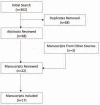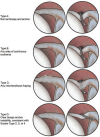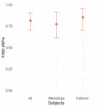Long Head of Biceps Tendinopathy: A Scoping Review of Classifications and Proposed Novel Classification System
- PMID: 40606699
- PMCID: PMC12212322
Long Head of Biceps Tendinopathy: A Scoping Review of Classifications and Proposed Novel Classification System
Abstract
Background: While authors have subclassified long head of biceps tendon (LHBT) lesions in numerous ways, there is no classification system based solely on the arthroscopic appearance of the LHBT. We present a scoping review of the existing classification systems for LHBT tendinopathy and propose a novel classification based on its intraoperative, arthroscopic appearance.
Methods: We conducted a comprehensive search of classification systems for LHBT pathology using EMBASE and Ovid-Medline platforms. Our proposed classification system consists of four types based on intraoperative arthroscopic appearance of the LHBT: normal (A), erythema without fraying (B), fraying (C), and labral anchor instability (D). Fourteen arthroscopic videos and thirteen photos were reviewed by three orthopaedic sports medicine surgeons and two orthopaedic sports medicine fellows. Intra-and inter-observer reliability were assessed using Krippendorff's Alpha (α).
Results: Seventeen full length articles were included in our review, including classification systems based on visual characteristics, advanced imaging, and histology. For our proposed classification, there was excellent inter- and intra-observer reliability between all reviewers (α=0.92). Interobserver reliability when reviewing arthroscopic photos was also excellent (α=0.81). There was excellent agreement for all reviewers between video and photo cases (α=0.81).
Conclusion: The current literature lacks a concise classification system for LHBT tendinopathy based on its intraoperative, arthroscopic appearance. Our proposed classification system is intended to offer a simple and reproducible way to describe LHBT tendinopathy based on intraoperative arthroscopic appearance of the tendon. This classification has excellent inter- and intra-observer reliability when reviewing arthroscopic video cases as well as excellent inter-observer reliability when reviewing arthroscopic photos. This serves as a validation of classification for a future planned randomized control trial comparing LHBT tenodesis to benign neglect in the setting of rotator cuff repair. Level of Evidence: III.
Keywords: biceps tendinopathy; classification; long head of biceps tendon; shoulder arthroscopy.
Copyright © The Iowa Orthopaedic Journal 2025.
Conflict of interest statement
Disclosures: The authors report no potential conflicts of interest related to this study.
Figures






References
-
- Snyder SJ, Ferkel RD. SLAP Lesions of the Shoulder. 1990;6(4) - PubMed
-
- Lafosse L, Reiland Y, Baier GP, Toussaint B, Jost B. Anterior and Posterior Instability of the Long Head of the Biceps Tendon in Rotator Cuff Tears: A New Classification Based on Arthroscopic Observations. Arthroscopy: The Journal of Arthroscopic & Related Surgery. 2007;23(1):73–80. doi: 10.1016/j.arthro.2006.08.025. doi: - DOI - PubMed
Publication types
MeSH terms
LinkOut - more resources
Full Text Sources
Medical
